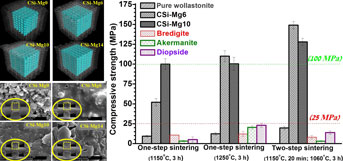Crossref Citations
This article has been cited by the following publications. This list is generated based on data provided by
Crossref.
He, Dongshuang
Zhuang, Chen
Xu, Sanzhong
Ke, Xiurong
Yang, Xianyan
Zhang, Lei
Yang, Guojing
Chen, Xiaoyi
Mou, Xiaozhou
Liu, An
and
Gou, Zhongru
2016.
3D printing of Mg-substituted wollastonite reinforcing diopside porous bioceramics with enhanced mechanical and biological performances.
Bioactive Materials,
Vol. 1,
Issue. 1,
p.
85.
Liu, An
Sun, Miao
Shao, Huifeng
Yang, Xianyan
Ma, Chiyuan
He, Dongshuang
Gao, Qing
Liu, Yanming
Yan, Shigui
Xu, Sanzhong
He, Yong
Fu, Jianzhong
and
Gou, Zhongru
2016.
The outstanding mechanical response and bone regeneration capacity of robocast dilute magnesium-doped wollastonite scaffolds in critical size bone defects.
Journal of Materials Chemistry B,
Vol. 4,
Issue. 22,
p.
3945.
He, Dongshuang
Zhuang, Chen
Chen, Cong
Xu, Sanzhong
Yang, Xianyan
Yao, Chunlei
Ye, Juan
Gao, Changyou
and
Gou, Zhongru
2016.
Rational Design and Fabrication of Porous Calcium–Magnesium Silicate Constructs That Enhance Angiogenesis and Improve Orbital Implantation.
ACS Biomaterials Science & Engineering,
Vol. 2,
Issue. 9,
p.
1519.
Zhuang, Chen
Ke, Xiurong
Jin, Zhouwen
Zhang, Lei
Yang, Xianyan
Xu, Sanzhong
Yang, Guojing
Xie, Lijun
Prince, Ghamor-Amegavi Edem
Pan, Zhijun
and
Gou, Zhongru
2017.
Core–shell-structured nonstoichiometric bioceramic spheres for improving osteogenic capability.
Journal of Materials Chemistry B,
Vol. 5,
Issue. 45,
p.
8944.
Shao, Huifeng
Ke, Xiurong
Liu, An
Sun, Miao
He, Yong
Yang, Xianyan
Fu, Jianzhong
Liu, Yanming
Zhang, Lei
Yang, Guojing
Xu, Sanzhong
and
Gou, Zhongru
2017.
Bone regeneration in 3D printing bioactive ceramic scaffolds with improved tissue/material interface pore architecture in thin-wall bone defect.
Biofabrication,
Vol. 9,
Issue. 2,
p.
025003.
Shao, Huifeng
Liu, An
Ke, Xiurong
Sun, Miao
He, Yong
Yang, Xianyan
Fu, Jianzhong
Zhang, Lei
Yang, Guojing
Liu, Yanming
Xu, Sanzhong
and
Gou, Zhongru
2017.
3D robocasting magnesium-doped wollastonite/TCP bioceramic scaffolds with improved bone regeneration capacity in critical sized calvarial defects.
Journal of Materials Chemistry B,
Vol. 5,
Issue. 16,
p.
2941.
Shao, H.
Sun, M.
Zhang, F.
Liu, A.
He, Y.
Fu, J.
Yang, X.
Wang, H.
and
Gou, Z.
2018.
Custom Repair of Mandibular Bone Defects with 3D Printed Bioceramic Scaffolds.
Journal of Dental Research,
Vol. 97,
Issue. 1,
p.
68.
Shen, Tao
Dai, Yuankun
Li, Xuguang
Xu, Sanzhong
Gou, Zhongru
and
Gao, Changyou
2018.
Regeneration of the Osteochondral Defect by a Wollastonite and Macroporous Fibrin Biphasic Scaffold.
ACS Biomaterials Science & Engineering,
Vol. 4,
Issue. 6,
p.
1942.
Du, Xiaoyu
Fu, Shengyang
and
Zhu, Yufang
2018.
3D printing of ceramic-based scaffolds for bone tissue engineering: an overview.
Journal of Materials Chemistry B,
Vol. 6,
Issue. 27,
p.
4397.
Yu, Xinning
Zhao, Tengfei
Qi, Yiying
Luo, Jianyang
Fang, Jinghua
Yang, Xianyan
Liu, Xiaonan
Xu, Tengjing
Yang, Quanming
Gou, Zhongru
and
Dai, Xuesong
2018.
In vitro Chondrocyte Responses in Mg-doped Wollastonite/Hydrogel Composite Scaffolds for Osteochondral Interface Regeneration.
Scientific Reports,
Vol. 8,
Issue. 1,
Jin, Zhouwen
Wu, Ronghuan
Shen, Jianhua
Yang, Xianyan
Shen, Miaoda
Xu, Wangqiong
Huang, Rong
Zhang, Lei
Yang, Guojing
Gao, Changyou
Gou, Zhongru
and
Xu, Sanzhong
2018.
Nonstoichiometric wollastonite bioceramic scaffolds with core-shell pore struts and adjustable mechanical and biodegradable properties.
Journal of the Mechanical Behavior of Biomedical Materials,
Vol. 88,
Issue. ,
p.
140.
Zheng, Wenjun
Wei, Qilin
Xun, Xiaojie
and
Su, Ming
2018.
Orthopedic Biomaterials.
p.
57.
Wang, Jingyi
Wang, Changjun
Jin, Kai
Yang, Xianyan
Gao, Lingling
Yao, Chunlei
Dai, Xizhe
He, Jinjing
Gao, Changyou
Ye, Juan
Li, Peng
and
Gou, Zhongru
2019.
Simultaneous enhancement of vascularization and contact-active antibacterial activity in diopside-based ceramic orbital implants.
Materials Science and Engineering: C,
Vol. 105,
Issue. ,
p.
110036.
Prince, Ghamor-Amegavi Edem
Yang, Xianyan
Fu, Jia
Pan, Zhijun
Zhuang, Chen
Ke, Xiurong
Zhang, Lei
Xie, Lijun
Gao, Changyou
and
Gou, Zhongru
2019.
Yolk-porous shell biphasic bioceramic granules enhancing bone regeneration and repair beyond homogenous hybrid.
Materials Science and Engineering: C,
Vol. 100,
Issue. ,
p.
433.
Zhang, Qiang
Wu, Wei
Qian, Chunyu
Xiao, Wanshu
Zhu, Huajun
Guo, Jun
Meng, Zhibing
Zhu, Jinyue
Ge, Zili
and
Cui, Wenguo
2019.
Advanced biomaterials for repairing and reconstruction of mandibular defects.
Materials Science and Engineering: C,
Vol. 103,
Issue. ,
p.
109858.
Wang, Su
Liu, Linlin
Zhou, Xin
Yang, Danfeng
Shi, Zhang’ao
and
Hao, Yongqiang
2019.
Effect of strontium-containing on the properties of Mg-doped wollastonite bioceramic scaffolds.
BioMedical Engineering OnLine,
Vol. 18,
Issue. 1,
Kamboj, Nikhil
Kazantseva, Jekaterina
Rahmani, Ramin
Rodríguez, Miguel A.
and
Hussainova, Irina
2020.
Selective laser sintered bio-inspired silicon-wollastonite scaffolds for bone tissue engineering.
Materials Science and Engineering: C,
Vol. 116,
Issue. ,
p.
111223.
Shaojie, DONG
Xudong, WANG
Steve Guofang, SHEN
Xiaohong, WANG
and
Kaili, LIN
2020.
Research Progress on Functional Modifications and Applications of Bioceramic Scaffolds.
Journal of Inorganic Materials,
Vol. 35,
Issue. 8,
p.
867.
Ke, Xiurong
Qiu, Jiandi
Wang, Xijuan
Yang, Xianyan
Shen, Jianhua
Ye, Shuo
Yang, Guojing
Xu, Sanzhong
Bi, Qing
Gou, Zhongru
Jia, Xiaofeng
and
Zhang, Lei
2020.
Modification of pore‐wall in direct ink writing wollastonite scaffolds favorable for tuning biodegradation and mechanical stability and enhancing osteogenic capability.
The FASEB Journal,
Vol. 34,
Issue. 4,
p.
5673.
Curti, Filis
Stancu, Izabela-Cristina
Voicu, Georgeta
Iovu, Horia
Dobrita, Cristina-Ioana
Ciocan, Lucian Toma
Marinescu, Rodica
and
Iordache, Florin
2020.
Development of 3D Bioactive Scaffolds through 3D Printing Using Wollastonite–Gelatin Inks.
Polymers,
Vol. 12,
Issue. 10,
p.
2420.
